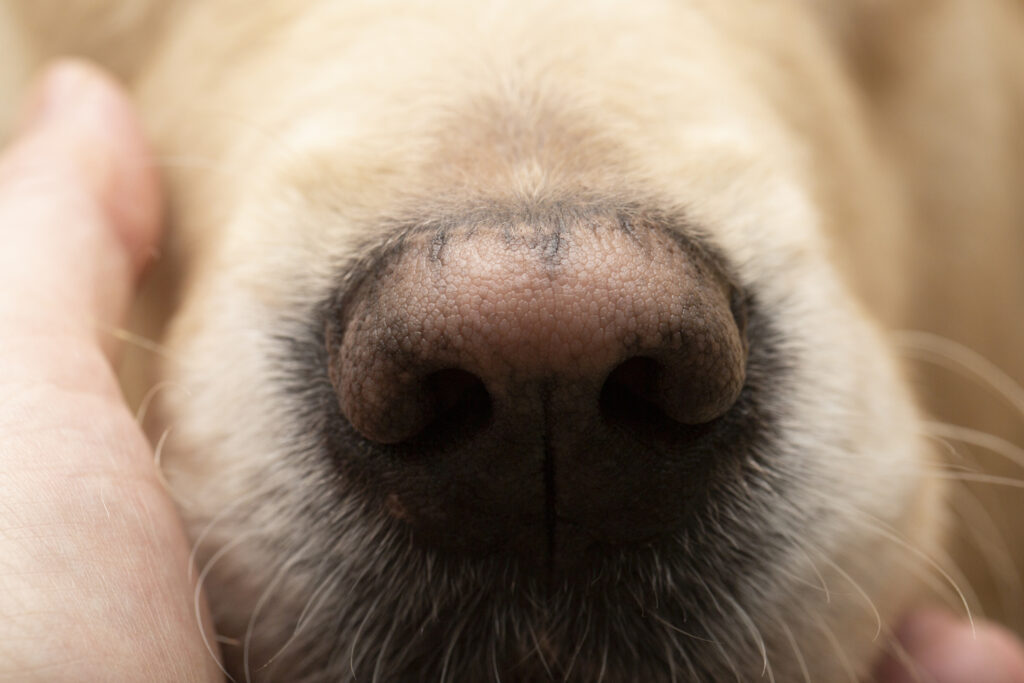Why Is My Dog’s Nose Turning Pink?

Photo by Aleksandr Potashev/iStock/Getty Images Plus
Most dogs have a dark nose—black or brown is common—but dog noses can start to look different for a variety of reasons. Some conditions are harmless (a snow nose dog, for example) while others require veterinary attention.
You’re in the right place if you’re wondering, “Why is my dog’s nose turning pink?” or if you’ve noticed other changes to your dog’s nose.
Key Takeaways
- Dog noses can turn pink due to harmless causes like snow nose or genetics, especially in certain breeds like Labs or Huskies.
- More serious causes include trauma, infections, or autoimmune conditions, especially if accompanied by scabbing, sores, or discomfort.
- Any new or worsening symptoms should prompt a vet visit to rule out underlying health issues and ensure appropriate treatment.
Why Do Dog Noses Change Color?
It can be alarming when you notice changes to your dog’s nose, even though color variations are relatively common.
Sometimes a dog is born with a lighter-than-normal tan or pink nose. This condition is called Dudley nose.
A similar condition called snow nose occurs when a dog is born with a dark nose that becomes lighter or turns pink. This often happens when it’s cold outside, although snow nose can occur at any time of year and in any climate.
While nose color changes like these are harmless, you should have your veterinarian examine your dog if the nose also shows other concerning symptoms such as:
- Cracking, crusting, or scaly patches
- Open sores, ulcers, or bleeding
- Loss of the nose’s normally bumpy texture
- Swelling, masses, or irregularities
- Signs of itching, pain, or discomfort
These warning signs can be associated with infections, autoimmune diseases, cancer, or other conditions that require treatment.
When in doubt, it’s always best to consult your vet about any changes to your dog’s nose.
5 Reasons Why Your Dog’s Nose Is Turning Pink
Melanin is the dark pigment that is responsible for dogs having a black or brown nose. When low levels of melanin are present, a dog’s nose will be a lighter tan color, and when melanin is absent, you’ll have a pink nose dog.
Let’s look at five reasons why dog noses can turn pink or change in other ways.
1. Seasons
We don’t know the exact mechanisms behind snow nose (also called winter nose or seasonal nasal hypopigmentation), but it’s thought that low light levels or cold temperatures reduce the activity of enzymes that are necessary to produce melanin in the exposed tissues not protected by fur) of a dog’s nose.
When spring arrives and days get longer, a dog’s nose may get darker again, though some retain the lighter color year-round.
Snow nose is purely cosmetic and doesn’t require any treatment.
Keep your pup warm with a winter coat or a dog blanket when it becomes colder, even if it doesn’t affect their snow nose.
Recommended Products
2. Genetics
The genes a dog is born with also play a role in nose color.
Snow nose most commonly affects certain breeds like:
Dudley nose primarily affects yellow and chocolate Labrador Retrievers, Irish Setters, and Pointers.
When conditions are more common in certain breeds than others, genetics is usually a contributing factor.
3. Vitiligo
Dudley nose and snow nose only affect the color of a dog’s nose.
Vitiligo, however, occurs when a dog’s immune system attacks the cells responsible for producing melanin in many places around their body.
This results in patches of white or pink skin and hair—not just on the nose but also around the eyes, lips, face, and elsewhere.
Breeds genetically predisposed to this condition include:
- Belgian Tervurens
- Dachshunds
- Doberman Pinschers
- German Shepherds
- German Shorthaired Pointers
- Rottweilers
- Old English Sheepdogs
While vitiligo is usually permanent, it’s purely cosmetic and doesn’t cause pain or health problems.
4. Trauma
If your dog has a wound on their nose, the area may appear pink as it heals. Most of the time, the tissue will begin producing melanin again, and your dog’s nose will return to its normal color.
Frequent trauma to the nose—such as rubbing the face due to chronic itchiness—can cause more lasting color changes.
Once the underlying problem is addressed, the dog’s nose should heal and regain its original color.
5. Other Underlying Medical Conditions
A dog’s nose may turn pink or change in additional ways because of other medical conditions, including:
- Autoimmune diseases. Discoid lupus erythematosus and uveodermatologic syndrome can cause a dog’s nose to turn pink, along with issues elsewhere in the body.
- Infections. Bacterial, fungal, or viral infections that affect a dog’s nose can damage skin and tissue, often making the nose appear red or dark pink.
- Respiratory disease. The nasal drainage that develops with many respiratory illnesses can irritate and inflame the nose, causing redness and discomfort.
- Cancer. Cancers such as epitheliotropic (cutaneous) lymphoma and squamous cell carcinoma can alter a dog’s nose in many ways.
This is not a complete list of all the health problems that can make your dog’s nose look different than it usually does.
If your dog’s nose has turned pink but they seem healthy otherwise, bring it to your veterinarian’s attention at your earliest convenience.
However, if your dog’s nose color change is accompanied by worrisome symptoms, schedule a veterinary examination as soon as possible.
Proper diagnosis and treatment are the best ways to get your dog quickly on the road to recovery.







